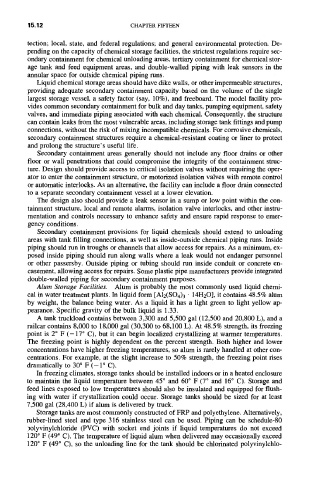Page 502 -
P. 502
15.12 CHAPTER HFTEEN
tection; local, state, and federal regulations; and general environmental protection. De-
pending on the capacity of chemical storage facilities, the strictest regulations require sec-
ondary containment for chemical unloading areas, tertiary containment for chemical stor-
age tank and feed equipment areas, and double-walled piping with leak sensors in the
annular space for outside chemical piping runs.
Liquid chemical storage areas should have dike walls, or other impermeable structures,
providing adequate secondary containment capacity based on the volume of the single
largest storage vessel, a safety factor (say, 10%), and freeboard. The model facility pro-
vides common secondary containment for bulk and day tanks, pumping equipment, safety
valves, and immediate piping associated with each chemical. Consequently, the structure
can contain leaks from the most vulnerable areas, including storage tank fittings and pump
connections, without the risk of mixing incompatible chemicals. For corrosive chemicals,
secondary containment structures require a chemical-resistant coating or liner to protect
and prolong the structure's useful life.
Secondary containment areas generally should not include any floor drains or other
floor or wall penetrations that could compromise the integrity of the containment struc-
ture. Design should provide access to critical isolation valves without requiring the oper-
ator to enter the containment structure, or motorized isolation valves with remote control
or automatic interlocks. As an alternative, the facility can include a floor drain connected
to a separate secondary containment vessel at a lower elevation.
The design also should provide a leak sensor in a sump or low point within the con-
tainment structure, local and remote alarms, isolation valve interlocks, and other instru-
mentation and controls necessary to enhance safety and ensure rapid response to emer-
gency conditions.
Secondary containment provisions for liquid chemicals should extend to unloading
areas with tank filling connections, as well as inside-outside chemical piping runs. Inside
piping should run in troughs or channels that allow access for repairs. As a minimum, ex-
posed inside piping should run along walls where a leak would not endanger personnel
or other passersby. Outside piping or tubing should run inside conduit or concrete en-
casement, allowing access for repairs. Some plastic pipe manufacturers provide integrated
double-walled piping for secondary containment purposes.
Alum Storage Facilities. Alum is probably the most commonly used liquid chemi-
cal in water treatment plants. In liquid form [A12(SO4)3 • 14H20], it contains 48.5% alum
by weight, the balance being water. As a liquid it has a light green to light yellow ap-
pearance. Specific gravity of the bulk liquid is 1.33.
A tank truckload contains between 3,300 and 5,500 gal (12,500 and 20,800 L), and a
railcar contains 8,000 to 18,000 gal (30,300 to 68,100 L). At 48.5% strength, its freezing
point is 2 ° F (-17 ° C), but it can begin localized crystallizing at warmer temperatures.
The freezing point is highly dependent on the percent strength. Both higher and lower
concentrations have higher freezing temperatures, so alum is rarely handled at other con-
centrations. For example, at the slight increase to 50% strength, the freezing point rises
dramatically to 30 ° F (-1 ° C).
In freezing climates, storage tanks should be installed indoors or in a heated enclosure
to maintain the liquid temperature between 45 ° and 60 ° F (7 ° and 16 ° C). Storage and
feed lines exposed to low temperatures should also be insulated and equipped for flush-
ing with water if crystallization could occur. Storage tanks should be sized for at least
7,500 gal (28,400 L) if alum is delivered by truck.
Storage tanks are most commonly constructed of FRP and polyethylene. Altematively,
rubber-lined steel and type 316 stainless steel can be used. Piping can be schedule-80
9olyvinylchloride (PVC) with socket end joints if liquid temperatures do not exceed
120 ° F (49 ° C). The temperature of liquid alum when delivered may occasionally exceed
120 ° F (49 ° C), so the unloading line for the tank should be chlorinated polyvinylchlo-

